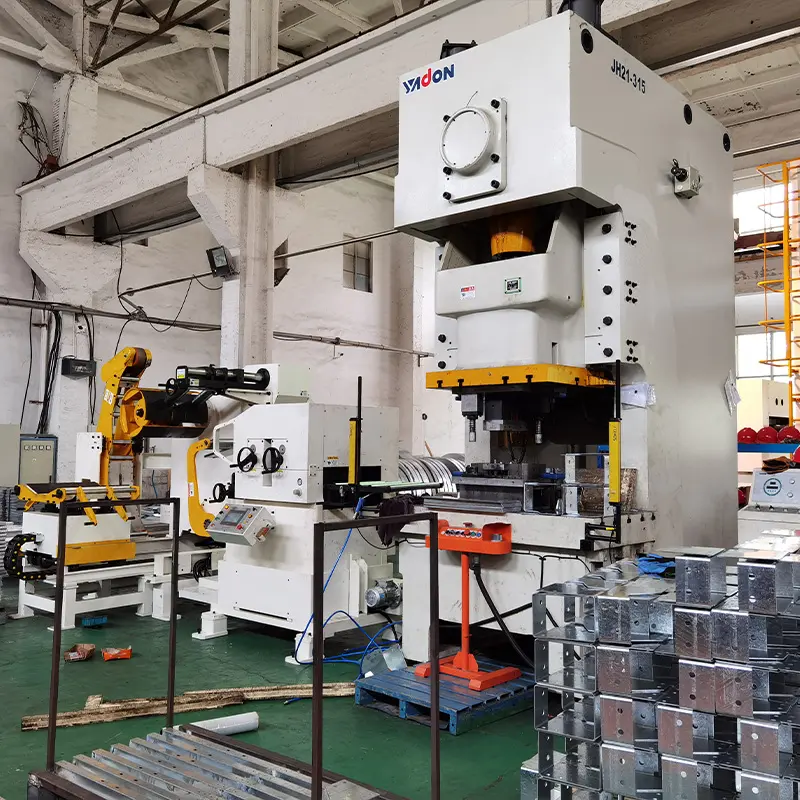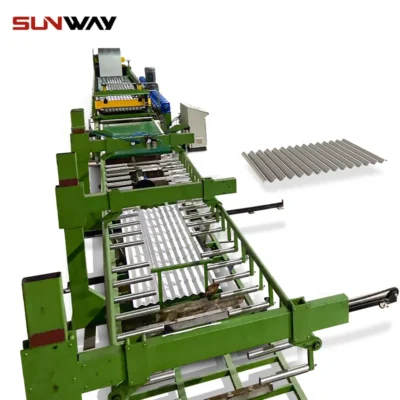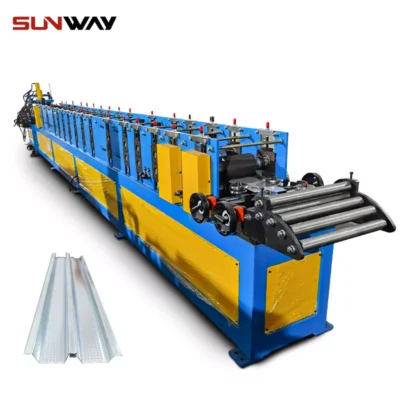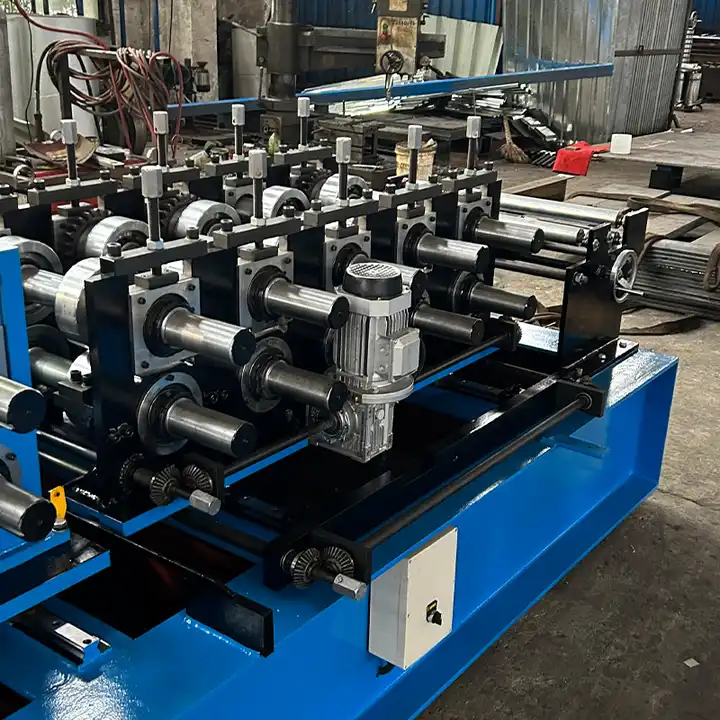Imagine a security guard that unfurls itself from a compact canister at your command, ready to shield your storefront or garage. That’s the magic of rolling shutter machines – versatile marvels of metal engineering that transform from coiled sheets to robust security barriers in seconds.
But these machines are far more than just security shields. They offer a multitude of benefits, from climate control to noise reduction. Buckle up, as we delve into the world of rolling shutter machines, exploring their functions, types, applications, and even answer some burning questions you might have.
Function of Rolling Shutter Machines
At their core, rolling shutter machines are designed to create a secure and controllable barrier. They consist of a motorized drive unit, a roller shaft, and interlocking slats – typically made of galvanized steel or aluminum – that unfurl vertically to create a solid wall.
The drive unit, powered by a motor (electric or manual), rotates the roller shaft, causing the interlocking slats to unwind and descend. This creates a smooth, continuous barrier that effectively blocks entry and deters unwanted attention.
Think of it like this: Imagine a metal curtain woven from interlocking chain links. That’s essentially the operating principle of a rolling shutter machine.
But the functionality goes beyond just security. These machines can be integrated with control systems, allowing for remote operation and timed activation. This adds a layer of convenience, letting you manage your shutters with a simple click or preset their operation for specific times.

Types of Rolling Shutter Machines
The world of rolling shutter machines isn’t a one-size-fits-all scenario. Different needs call for different features and functionalities. Here’s a breakdown of the most common types:
- Solid Rolling Shutters: These are the workhorses, offering maximum security and privacy with their solid metal slats. They’re ideal for high-security applications like protecting shops and warehouses.
- Perforated Rolling Shutters: These shutters provide a balance between security and ventilation. Perforations allow for airflow and some visibility, making them suitable for garages and workshops where air circulation is crucial.
- Insulated Rolling Shutters: Imagine a rolling shutter that acts like a thermal blanket. Insulated shutters incorporate foam or other insulating materials within the slats, enhancing temperature control and energy efficiency. Perfect for applications where maintaining a specific temperature is important.
- Hurricane Rolling Shutters: For areas prone to extreme weather, hurricane shutters are built to withstand heavy winds and flying debris. They’re constructed with reinforced slats and sturdy frames, offering superior protection against the elements.
- Fire-Rated Rolling Shutters: These shutters provide an additional layer of fire safety. They’re constructed with fire-resistant materials that can delay the spread of flames, buying precious time in case of a fire.
Choosing the right type? It’s all about needs assessment. Consider factors like security level required, ventilation needs, fire safety concerns, and of course, aesthetics.
For example, a high-end jewelry store might prioritize solid rolling shutters for maximum security, while a bakery might opt for perforated shutters to allow for ventilation and prevent heat buildup.
Here’s a table summarizing the function, types, applications, and other key details of rolling shutter machines:
| Feature | Description |
|---|---|
| Function | Create a secure and controllable barrier |
| Components | Motorized drive unit, roller shaft, interlocking slats |
| Operation | Slats unfurl vertically to create a solid wall |
| Benefits | Security, climate control, noise reduction |
| Types | Solid, Perforated, Insulated, Hurricane-Rated, Fire-Rated |
| अनुप्रयोग | Shops, warehouses, garages, workshops, commercial buildings, homes |
Please note: This table provides a general overview. Specific functionalities and applications may vary depending on the manufacturer and model.
Applications of Rolling Shutter Machines
The applications of rolling shutter machines are as diverse as the needs they address. Here’s a glimpse into some of the most common uses:
- Security: Rolling shutters are a popular choice for securing storefronts, warehouses, and other commercial properties. They deter break-ins, vandalism, and unwanted access.
- Climate Control: Insulated rolling shutters can help maintain consistent temperatures within a space. This is beneficial for businesses like restaurants and supermarkets that need to control temperature for food storage.
- Noise Reduction: Solid rolling shutters act as a barrier against external noise pollution. This is valuable for businesses and homes located in noisy areas.
- Storm Protection: Hurricane-rated rolling shutters provide crucial protection against severe weather. They can safeguard homes and businesses from damaging winds, flying debris, and even floodwaters (in some cases).
- Light Control: Perforated rolling shutters allow for some degree of light control. This can be beneficial for photographers or artists who need to control the amount of natural light entering their workspace.
- Aesthetics: Rolling shutters aren’t just about function; they can also enhance the visual appeal of a building. Available in various colors and finishes, they can complement the architectural style of a property.
Beyond these common applications, rolling shutter machines can be surprisingly versatile. They can be used to secure:
- Loading docks
- ATM booths
- Concession stands
- Car washes
- Data centers
The possibilities are truly vast, limited only by your imagination and specific needs.
-
 रोलिंग शटर स्लेट रोल बनाने की मशीन
रोलिंग शटर स्लेट रोल बनाने की मशीन -
 Highway Guardrail End Terminal Forming Machine
Highway Guardrail End Terminal Forming Machine -
 Highway U/C Post Roll Forming Machine
Highway U/C Post Roll Forming Machine -
 2 Waves Highway Guardrail Roll Forming Machine
2 Waves Highway Guardrail Roll Forming Machine -
 3 Waves Highway Guardrail Roll Forming Machine
3 Waves Highway Guardrail Roll Forming Machine -
 नालीदार पैनल रोल बनाने की मशीन
नालीदार पैनल रोल बनाने की मशीन -
 लाइट गेज स्टील रोल बनाने की मशीन
लाइट गेज स्टील रोल बनाने की मशीन -
 स्टील बॉक्स प्लेट रोल बनाने की मशीन बनाना
स्टील बॉक्स प्लेट रोल बनाने की मशीन बनाना -
 विद्युत कैबिनेट फ्रेम रोल बनाने की मशीन
विद्युत कैबिनेट फ्रेम रोल बनाने की मशीन
Advantages and Disadvantages of Rolling Shutter Machines
Like any product, rolling shutter machines come with their own set of pros and cons. Let’s take a balanced look:
Advantages:
- Enhanced Security: Rolling shutters create a robust physical barrier, deterring theft and vandalism.
- Improved Climate Control: Insulated shutters can significantly improve energy efficiency by maintaining consistent temperatures within a space.
- Noise Reduction: Solid shutters act as effective sound barriers, creating a quieter environment.
- Storm Protection: Hurricane-rated shutters offer vital protection against severe weather events.
- Versatility: Rolling shutters come in various types and configurations, catering to a wide range of applications.
- Durability: Made from sturdy materials like steel and aluminum, these machines are built to last.
- Convenience: Modern rolling shutters can be integrated with control systems, allowing for remote operation and automation.
Disadvantages:
- Cost: Rolling shutter machines can be a significant investment, especially for larger installations.
- Maintenance: Regular maintenance is necessary to ensure smooth operation and prevent breakdowns.
- Weight: Solid metal shutters can be quite heavy, requiring a sturdy support system.
- Aesthetics: Solid shutters can create a somewhat imposing look, which might not be ideal for all architectural styles.
- Power Dependence: Electrically operated shutters rely on a functional power source to operate.
The decision to install rolling shutters hinges on a careful evaluation of your needs and priorities. Consider factors like your budget, security requirements, climate control needs, and aesthetic preferences.
Suppliers and Pricing of Rolling Shutter Machines
The market for rolling shutter machines is brimming with options. Here’s a glimpse into some of the prominent suppliers and their pricing structures:
| Supplier | Price Range (Estimated) | Specialties |
|---|---|---|
| Amaro Rolling Shutters | $1,500 – $5,000+ | Custom-made shutters, fire-rated options |
| Cornell Iron Works | $800 – $3,000 | Hurricane-rated shutters, insulated shutters |
| Garaga | $1,000 – $4,000 | Wide variety of colors and finishes, automated controls |
| Hormann | $2,000 – $6,000+ | High-security shutters, high-tech automation systems |
| LiftMaster | $500 – $2,000 | Budget-friendly options, DIY kits |
Please note: These are estimated price ranges and can vary depending on factors like size, type, features, and customization options. It’s crucial to contact suppliers directly for accurate quotes.
Beyond price, consider these factors when choosing a supplier:
- Reputation: Research the supplier’s reputation for quality, customer service, and warranty coverage.
- Customization Options: Does the supplier offer custom sizes, colors, and features to meet your specific needs?
- Installation Services: Do they offer professional installation services or is it a DIY project?
- Warranty: A strong warranty ensures peace of mind and protects your investment.
Remember, the cheapest option isn’t always the best. Invest in a reputable supplier that offers quality products, exceptional service, and a warranty that provides peace of mind.

सामान्य प्रश्न
Q: How much does a rolling shutter machine cost?
A: Rolling shutter machines can range in price from $500 (DIY kits) to upwards of $6,000+ (custom-made, high-security options). The final cost depends on factors like size, type, features, and customization.
Q: Are rolling shutter machines difficult to maintain?
A: Rolling shutter machines generally require minimal maintenance. Regular cleaning (dust removal) and lubrication of moving parts are key. Some manufacturers might recommend professional inspections periodically, especially for heavy-duty applications. Compared to other security solutions, rolling shutters are considered low-maintenance.
Q: Can I install a rolling shutter machine myself (DIY)?
A: Yes, some manufacturers offer DIY kits for smaller, lighter shutters. These kits typically come with detailed instructions and pre-cut components for easier assembly. However, for larger, heavier shutters or those requiring complex wiring for automation, professional installation is highly recommended. Improper installation can compromise security and functionality, potentially leading to safety hazards.
Q: How secure are rolling shutter machines?
A: The security level of a rolling shutter machine depends on the type and materials used. Solid metal shutters with sturdy locking mechanisms offer the highest level of security, ideal for high-risk applications like jewelry stores. Perforated shutters provide a balance between security and ventilation, suitable for areas where some visibility is desired.
